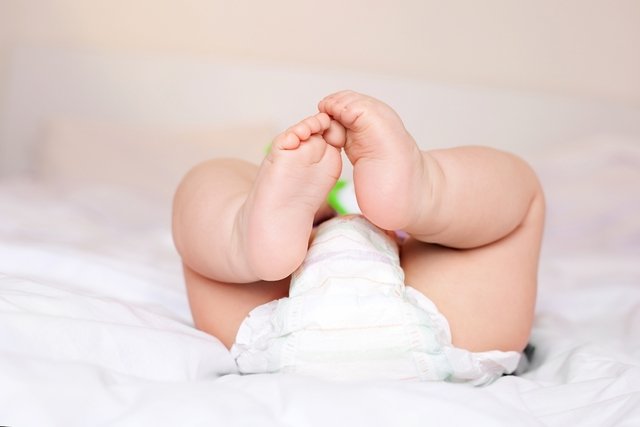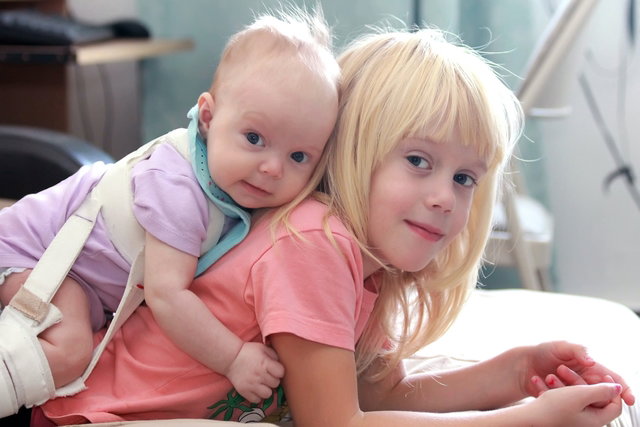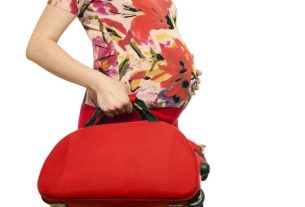Hip dysplasia in babies, also known as congenital dysplasia or developmental dysplasia of the hip, is a condition where the baby is born with an imperfect fit between the femur and the hip bone, which causes the joint to become looser and cause decreased hip mobility and changes in limb length.
This type of dysplasia is more common when there are low levels of amniotic fluid during pregnancy or when the baby is in a sitting position for most of the pregnancy. Furthermore, the position in which the baby is born can also interfere with the development of the joint, which is more common when the first part of the baby to emerge during birth is the buttocks and then the rest of the body.
Since it can affect the baby’s development and cause difficulty walking, diagnosis by a pediatrician should be made as soon as possible so that treatment can begin and the dysplasia can be cured completely.

How to identify dysplasia
In many cases, hip dysplasia does not cause any type of visible sign and, therefore, the most important thing is to maintain regular consultations with the pediatrician after birth, as the doctor will assess over time how the baby is developing. , identifying any problems that may arise.
However, there are also babies who may show signs of hip dysplasia, such as:
- Legs with different lengths or facing outward;
- Reduced mobility and flexibility of one of the legs, which can be observed during diaper changes;
- Folds of skin on the thigh and buttock with very different sizes;
- Delay in the baby’s development, which affects the way they sit, crawl or walk.
If dysplasia is suspected, you should notify your pediatrician so that an evaluation and diagnosis can be made.
How the doctor identifies dysplasia
There are some orthopedic tests that the pediatrician must perform in the first 3 days after birth, but these tests must also be repeated at the appointment on the 8th and 15th day of birth and include:
- Barlow testin which the doctor holds the baby’s legs together and folded and presses from top to bottom;
- Teste de Ortolani, in which the doctor holds the baby’s legs and checks the range of movement of the hip opening. The doctor may conclude that the hip fit is not perfect if they hear a clicking sound during the test or feel a bump in the joint;
- Teste de Galeazziin which the doctor places the baby lying down with legs bent and feet supported on the examination table, allowing the difference in knee height to be seen.
These tests are carried out until the baby is 3 months old, after this age the symptoms observed by the doctor that may indicate hip dysplasia are delay in the baby’s development in sitting, crawling or walking, difficulty in the child walking, less flexibility of the affected leg or difference in leg length if only a single side of the hip is affected.
To confirm the diagnosis of hip dysplasia, your doctor may order imaging tests such as ultrasounds for babies under 6 months of age and X-rays for older babies and children.

How the treatment is carried out
Treatment for congenital hip dysplasia can be done with the use of a special type of braces, the use of a cast that goes from the chest to the feet or surgery, and should always be guided by the pediatrician.
Typically, treatment is selected according to the baby’s age:
1. Up to 6 months of life
When dysplasia is discovered shortly after birth, the first choice of treatment is the Pavlik brace which attaches to the baby’s legs and chest and can be worn for 6 to 12 weeks, depending on the baby’s age and the severity of the disease. . With this brace, the baby’s leg is always bent and open, as this position is ideal for the hip joint to develop normally.
After 2 to 3 weeks of placing this brace, the baby should be examined again so that the doctor can see if the joint is properly positioned. If it is not there, the brace is removed and a cast is placed, but if the joint is properly positioned, the brace should be kept in place until the child no longer has any changes in the hip, which can happen in 1 month or up to 4 months.
These suspenders must be kept on throughout the day and night, and can only be removed to bathe the baby and must be put back on immediately afterwards. Using the Pavlik brace does not cause any pain and the baby gets used to it within a few days, so it is not necessary to remove the brace if you think the baby is irritable or crying.
2. Between 6 months and 1 year
When dysplasia is only discovered when the baby is over 6 months old, treatment can be carried out by manually placing the joint in place by the orthopedist and using a cast immediately afterwards to maintain the correct positioning of the joint.
The plaster must be kept for 2 to 3 months and then another device, such as the Milgram, must be used for another 2 to 3 months. After this period, the child must be evaluated again to check whether development is happening correctly. If not, your doctor may recommend surgery.
3. After starting to walk
When the diagnosis is made later, after the child has started to walk, treatment is usually done with surgery. This is because the use of Pavlik plaster and braces is not effective after the first year of age.
Diagnosis after this age is late and what catches the parents’ attention is that the child walks with a limp, walks only on the tips of his toes or does not like to use one of his legs. Confirmation is made through X-ray, MRI or ultrasound that show changes in the positioning of the femur in the hip.

Possible complications of dysplasia
When dysplasia is discovered late, months or years after birth, there is a risk of complications and the most common is that one leg becomes shorter than the other, which causes the child to always walk with a limp, making it necessary to wear shoes made tailored to try to adapt the height of the two legs.
Furthermore, a child can develop osteoarthritis in the hip at a young age, scoliosis in the spine and suffer from pain in the legs, hips and back, in addition to having to walk with the help of crutches, requiring physiotherapy for long periods.
How to prevent hip dysplasia
Most cases of hip dysplasia cannot be avoided, however, to reduce the risk after birth, you should avoid putting too much clothing on the baby that hinders movement, and not leaving the baby curled up for too long with legs stretched out. or pressed against each other, as this can affect hip development.
Furthermore, observing movements and checking whether the baby can move their hips and knees can help detect changes that should be reported to the pediatrician for diagnosis and starting the most appropriate treatment to avoid complications.

Sign up for our newsletter and stay up to date with exclusive news
that can transform your routine!
Warning: Undefined array key "title" in /home/storelat/public_html/wp-content/plugins/link-whisper-premium/templates/frontend/related-posts.php on line 12
Warning: Undefined array key "title_tag" in /home/storelat/public_html/wp-content/plugins/link-whisper-premium/templates/frontend/related-posts.php on line 13



